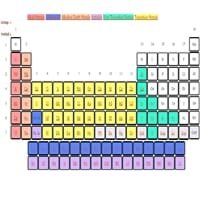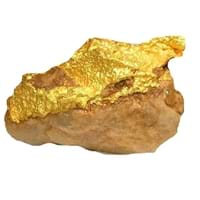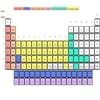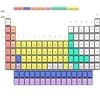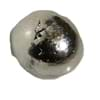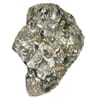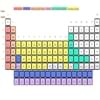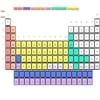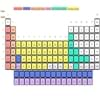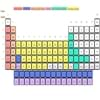Seaborgium vs Gold
Periodic Table
Symbol
Sg
Au
Group Number
6
12
11
7
Period Number
7
6
Block
d block
d block
Element Family
Transition Metal
Transition Metal
CAS Number
54038812
9
7440575
31
Space Group Name
Not Available
Fm_ 3m
Space Group Number
Not Available
225.00
2
Facts
Interesting Facts
- Seaborgium most stable isotope is Sg and it has 2.1 min of half- life.
- And other isotopes of Seaborgium have half-lives as short as 3 ms.
- It is found in copper ores and from the crust of the earth.
- It is the most malleable and ductile metal.
- Gold alloys are used in Dentistry as fillings, crowning, clips, etc. It is also used as an artificial limb joints.
Sources
Synthetically Produced
Earth's crust, Mining, Ores of metals
History
Who Discovered
Lawrence Berkeley National Laboratory
Unknown
Discovery
In 1974
Before 6000 BCE
Abundance
Abundance In Universe
Not Available
6 * 10-8 %
26
Abundance In Sun
~-9999 %
~0.0000001 %
26
Abundance In Meteorites
Not Available
0.00 %
99+
Abundance In Earth's Crust
Not Available
0.00 %
99+
Abundance In Oceans
Not Available
0.00 %
21
Abundance In Humans
Not Available
0.00 %
18
Uses
Uses & Benefits
- Currently known uses of Seaborgium metal are limited to research purpose only.
- Gold metal is mainly used for Jewelry, bullion, coinage, etc.
- It is used in the art, decoration, ornaments, etc. It is also used for electroplating process.
Industrial Uses
NA
Chemical Industry, Clothing Industry, Electrical Industry, Electronic Industry
Medical Uses
NA
Dentistry, Pharmaceutical Industry
Other Uses
Research Purposes
Alloys, Bullion, Coinage, Jewellery, Sculptures, Statues
Biological Properties
Toxicity
Unknown
Non Toxic
Present in Human Body
No
Yes
In Blood
Not Available
0.00 Blood/mg dm-3
35
In Bone
Not Available
0.02 p.p.m.
30
Physical Properties
Melting Point
Not Available
1,064.43 °C
99+
Boiling Point
Not Available
2,807.00 °C
36
Appearance
Physical State
Solid
Solid
Color
Unknown
Gold
Luster
Unknown Luster
Metallic
Hardness
Mohs Hardness
Not Available
2.50
14
Brinell Hardness
Not Available
194.00 MPa
99+
Vickers Hardness
Not Available
216.00 MPa
31
Speed of Sound
Not Available
2,030.00 m/s
99+
Optical Properties
Reflectivity
Not Available
95.00 %
2
Allotropes
No
No
α Allotropes
Not Available
Not Available
β Allotropes
Not Available
Not Available
γ Allotropes
Not Available
Not Available
Chemical Properties
Chemical Formula
Sg
Au
Isotopes
Known Isotopes
9
29
36
3
Electronegativity
Pauling Electronegativity
Not Available
2.54
1
Allred Rochow Electronegativity
Not Available
1.42
18
Mulliken-Jaffe Electronegativity
Not Available
1.87
7
Allen Electronegativity
Not Available
1.92
5
Electropositivity
Pauling Electropositivity
Not Available
1.46
99+
Ionization Energies
1st Energy Level
757.40 kJ/mol
21
890.10 kJ/mol
8
2nd Energy Level
1,732.90 kJ/mol
28
1,980.00 kJ/mol
12
3rd Energy Level
2,483.50 kJ/mol
99+
Not Available
4th Energy Level
3,415.60 kJ/mol
99+
Not Available
5th Energy Level
4,561.80 kJ/mol
38
Not Available
6th Energy Level
5,715.80 kJ/mol
25
Not Available
Electrochemical Equivalent
Not Available
2.45 g/amp-hr
21
Electron Work Function
Not Available
5.10 eV
4
Other Chemical Properties
NA
Chemical Stability, Ionization, Solubility
Atomic Properties
Atomic Number
106
12
79
37
Electron Configuration
[Rn] 5f14 6d2 7s2
[Xe] 4f14 5d10 6s1
Crystal Structure
Body Centered Cubic (BCC)
Face Centered Cubic (FCC)
Crystal Lattice
BCC-Crystal-Structure-.jpg#100
FCC-Crystal-Structure-of-Gold.jpg#100
Atom
Number of Protons
106
12
79
37
Number of Neutrons
157
7
118
23
Number of Electrons
106
12
79
37
Radius of an Atom
Atomic Radius
132.00 pm
99+
151.00 pm
32
Covalent Radius
143.00 pm
99+
144.00 pm
40
Van der Waals Radius
Not Available
166.00 pm
39
Atomic Weight
269.00 amu
9
196.97 amu
33
Atomic Volume
Not Available
10.20 cm3/mol
99+
Adjacent Atomic Numbers
Valence Electron Potential
Not Available
43.40 (-eV)
99+
Lattice Constant
Not Available
407.82 pm
21
Lattice Angles
Unknown
π/2, π/2, π/2
Lattice C/A Ratio
Not Available
1.61
4
Mechanical Properties
Density
Density At Room Temperature
35.00 g/cm3
4
19.30 g/cm3
15
Density When Liquid (at m.p.)
Not Available
17.31 g/cm3
6
Tensile Strength
Not Available
120.00 MPa
15
Viscosity
Not Available
Not Available
Vapor Pressure
Vapor Pressure at 1000 K
Not Available
0.00 (Pa)
23
Vapor Pressure at 2000 K
Not Available
67.00 (Pa)
4
Elasticity properties
Shear Modulus
Not Available
27.00 GPa
27
Bulk Modulus
Not Available
180.00 GPa
9
Young's Modulus
Not Available
79.00 GPa
24
Poisson Ratio
Not Available
0.40
4
Other Mechanical Properties
Unknown
Ductile, Malleable
Magnetic Properties
Magnetic Characteristics
Specific Gravity
Not Available
19.32
8
Magnetic Ordering
Unknown
Diamagnetic
Electrical Properties
Electrical Property
Unknown
Conductor
Resistivity
Not Available
2.20 nΩ·m
99+
Electrical Conductivity
Not Available
0.45 106/cm Ω
3
Electron Affinity
Not Available
222.80 kJ/mol
1
Thermal Properties
Specific Heat
Not Available
0.13 J/(kg K)
39
Molar Heat Capacity
Not Available
25.42 J/mol·K
40
Thermal Conductivity
Not Available
318.00 W/m·K
3
Critical Temperature
Not Available
Not Available
Thermal Expansion
Not Available
14.20 µm/(m·K)
26
Enthalpy
Enthalpy of Vaporization
Not Available
324.40 kJ/mol
27
Enthalpy of Fusion
Not Available
12.55 kJ/mol
27
Enthalpy of Atomization
Not Available
364.00 kJ/mol
25
Standard Molar Entropy
Not Available
47.40 J/mol.K
32
|
||
|
||
|
